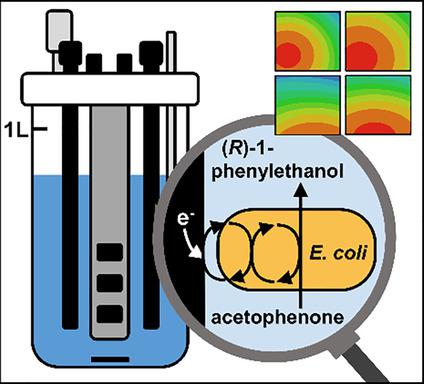当前位置:
X-MOL 学术
›
ChemSusChem
›
论文详情
Our official English website, www.x-mol.net, welcomes your
feedback! (Note: you will need to create a separate account there.)
Response-Surface-Optimized and Scaled-Up Microbial Electrosynthesis of Chiral Alcohols.
ChemSusChem ( IF 7.5 ) Pub Date : 2020-03-05 , DOI: 10.1002/cssc.201903428 Jeannine C Mayr 1, 2 , Luis F M Rosa 3 , Natalia Klinger 1 , Jan-Hendrik Grosch 1, 2, 4 , Falk Harnisch 3 , Antje C Spiess 1, 2, 4
ChemSusChem ( IF 7.5 ) Pub Date : 2020-03-05 , DOI: 10.1002/cssc.201903428 Jeannine C Mayr 1, 2 , Luis F M Rosa 3 , Natalia Klinger 1 , Jan-Hendrik Grosch 1, 2, 4 , Falk Harnisch 3 , Antje C Spiess 1, 2, 4
Affiliation

|
A variety of enzymes can be easily incorporated and overexpressed within Escherichia coli cells by plasmids, making it an ideal chassis for bioelectrosynthesis. It has recently been demonstrated that microbial electrosynthesis (MES) of chiral alcohols is possible by using genetically modified E. coli with plasmid-incorporated and overexpressed enzymes and methyl viologen as mediator for electron transfer. This model system, using NADPH-dependent alcohol dehydrogenase from Lactobacillus brevis to convert acetophenone into (R)-1-phenylethanol, is assessed by using a design of experiment (DoE) approach. Process optimization is achieved with a 2.4-fold increased yield of 94±7 %, a 3.9-fold increased reaction rate of 324±67 μm h-1 , and a coulombic efficiency of up to 68±7 %, while maintaining an excellent enantioselectivity of >99 %. Subsequent scale-up to 1 L by using electrobioreactors under batch and fed-batch conditions increases the titer of (R)-1-phenylethanol to 12.8±2.0 mm and paves the way to further develop E. coli into a universal chassis for MES in a standard biotechnological process environment.
中文翻译:

手性醇的响应表面优化和放大微生物电合成。
多种酶可以很容易地通过质粒在大肠杆菌细胞内掺入并过度表达,使其成为生物电合成的理想基础。最近已经证明,通过使用带有质粒掺入和过表达酶的转基因大肠杆菌以及甲基紫精作为电子转移介体,可以实现手性醇的微生物电合成(MES)。该模型系统使用短乳杆菌中的 NADPH 依赖性乙醇脱氢酶将苯乙酮转化为 (R)-1-苯基乙醇,并通过实验设计 (DoE) 方法进行评估。工艺优化,收率提高 2.4 倍,达到 94±7 %,反应速率提高 3.9 倍,达到 324±67 μm h-1 ,库仑效率高达 68±7 %,同时保持优异的对映选择性>99%。随后在分批和补料分批条件下使用电生物反应器将其放大至 1 L,将 (R)-1-苯基乙醇的滴度提高至 12.8±2.0 mm,并为进一步将大肠杆菌开发为 MES 的通用底盘铺平了道路。标准的生物技术工艺环境。
更新日期:2020-03-05
中文翻译:

手性醇的响应表面优化和放大微生物电合成。
多种酶可以很容易地通过质粒在大肠杆菌细胞内掺入并过度表达,使其成为生物电合成的理想基础。最近已经证明,通过使用带有质粒掺入和过表达酶的转基因大肠杆菌以及甲基紫精作为电子转移介体,可以实现手性醇的微生物电合成(MES)。该模型系统使用短乳杆菌中的 NADPH 依赖性乙醇脱氢酶将苯乙酮转化为 (R)-1-苯基乙醇,并通过实验设计 (DoE) 方法进行评估。工艺优化,收率提高 2.4 倍,达到 94±7 %,反应速率提高 3.9 倍,达到 324±67 μm h-1 ,库仑效率高达 68±7 %,同时保持优异的对映选择性>99%。随后在分批和补料分批条件下使用电生物反应器将其放大至 1 L,将 (R)-1-苯基乙醇的滴度提高至 12.8±2.0 mm,并为进一步将大肠杆菌开发为 MES 的通用底盘铺平了道路。标准的生物技术工艺环境。











































 京公网安备 11010802027423号
京公网安备 11010802027423号